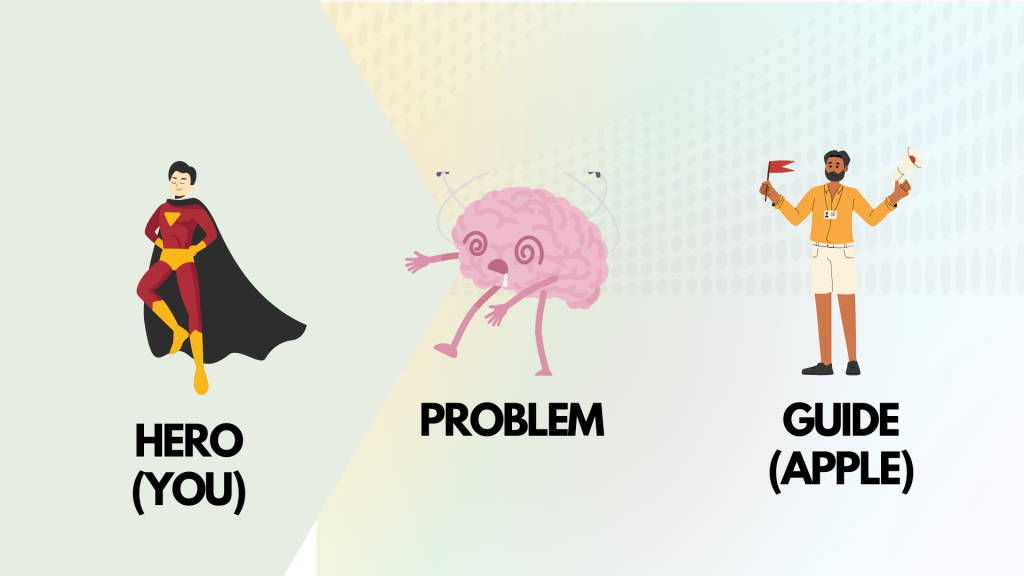Storytelling finds its roots in movies. If you think about your top three movies, you’ll find that their stories are similar. they all have a hero with a problem, a guide that helps the hero solve the problem, and either a happy or sad ending. That’s exactly what keeps customers engaged.
1- The power of storytelling in advertising
a. What is storytelling?
Storytelling is the way brands connect with their customers through giving them solutions to their challenges in an engaging and memorable way. Customers will feel like the hero in the story and the brand is the guide that will appear.

For storytelling to be successful for businesses, the most important thing is clarity. Miller explains it in a process of seven elements which are:
Miller’s seven elements in storytelling:
- Character: The customer is the story’s hero, not the brand.
- Problem: Find the customer’s problem.
- Guide: Getting the customer to trust that the product will solve his problem by showing both empathy and authority.
- Plan: put a clear and simple plan to solve the problem.
- Call to action: Invite the customer to take action (through call-to-action buttons that should be positioned perfectly)
- Avoid failure: Make them know the risks if the problem is not solved.
- Success: Show the positive transformation or success they’ll achieve once the problem is solved.
Apple always highlights how their iPhone can make their customers’ life easier. For example, through their campaign “shot on iPhone macro challenge” (Apple, 2022) “Shot on iPhone macro challenge” :
- Character: Apple shows how ordinary people can express themselves through extraordinary results. The iPhone here is just acting as a tool.
- Problem: Apple understands the frustration people feel when they don’t capture their important moments, this campaign is basically telling us: be your own professional photographer anytime anywhere!
- Guide: Apple acts like a guide by showing their empathy for people who want both quality and simplicity, while showing authority through their reputation (design and technology).
- Plan: Just the iPhone to reveal hidden beauty of everyday objects.
- Call to action: It invites customers to join the challenge and share their best shots.
- Avoid failure: Without the iPhone’s macro lens, people will miss out on the potential of mobile photography.
- Success: Apple shows that with just the iPhone, users can turn everyday moment into extraordinary detailed pictures.
b. Why storytelling is important
Humans second worst enemy after Maslow’s needs is boredom (Scitovsky, 1992).We are always looking for either mental or physical stimuli that keeps our brain busy. In business, this stimuli is storytelling, it keeps the brain engaged and creates some kind of emotional connection with customers.
In this digital age, consumers keep getting spammed with ads that look exactly the same and sound exactly the same. Keeping them engaged now is tougher than it has ever been and storytelling is here to cut through this chaotic noise.
c. Building emotional connections with storytelling
Since people tend to get bored quickly, stories must form some sort of emotional connection with them in order to keep them engaged. An example of this is Apple’s campaign “Dear apple” “Dear apple” which was a 2 minute video of apple customer from all around the world showing how much the apple watch changed their lives, it had a very emotional aspect to it where people talked about their real life experiences with the apple watch and how it saved them and changed their lives.
Another aspect of this campaign is that the video was in form of hand-written letters people were reading, it felt more like a love letter which adds up a touch of heart warmth and trust.
2- Neuromarketing techniques to measure emotional response
a. What is neuromarketing?
Neuromarketing is studying how the brain responds to advertisements, by checking the neuroimages, and tracking where the eyes move as well as other techniques.
b. Using neuromarketing to measure emotional response
fMRI: It can accurately identify which areas of the brain are activated, which helps brands know which part of their story had the most effect on people’s emotions.
EEG: It visualizes the electrical waves in the brain, which helps brands know how focused the viewers stay and how each scene affected them.
Eye-Tracking: It tracks viewers eye movements through the eye’s fixation points and pupil dilation.
A/B Testing: By showing a different version of the story to each viewer, brands can know which story was more of a success in accessing people’s hearts.
3- Using web analytics to measure the impact of emotional storytelling
To measure the effectiveness of the neuromarketing techniques, brands use metrics that help them quantify the data.
CTR (click-through rate): It indicates how many times viewers clicked on the ad or link after seeing it.
Conversion rate: by tracking how many of the viewers complete the desired action such as participation in the “shot on iPhone” campaign. The higher it is the more it means that the story successfully relates to the customer’s feelings and needs.
Time on page: When the viewer stays longer in the ad, it means that the story kept him interested and engaged.
4- Apple’s storytelling techniques
Apple uses many storytelling techniques such as suspense by teasing their customers with glimpses of the new features of the new iPhone releases. They create an element of surprise by turning everyday moments into something extraordinary like in their “shot on iPhone” campaign. Apple also focuses on keeping their ads simple like their “dear apple” campaign. Finaly, Apple show empathy towards their customers by giving them solutions to their frustrations, it creates an emotional connection where customers feel cared about.
5- Where I stand on emotional storytelling in advertising
I believe that it’s one of the most amazing advertising techniques to ever exist. I mean, what’s better than learning about a brand than listening to a story that makes us feel connected to it? When brands tell a story, it’s not just about what they sell – it’s more about creating a sense of shared experiences. This makes the ad feel more personal, almost like a friend who understands us.
In a world where ads keep popping up every few seconds infront of us, a personalized story is what will stand out. We won’t feel like we’re buying the product anymore, instead, we will feel like we’re part of something bigger. We are the heroes of the story and that product is our solution to having a happy ending.
These emotion tracking methods will make us feel something that will take not only the big companies but also the small businesses into a whole new era of actually getting their customers to connect and engage with their ads.
6- The future of emotionally engaging stories
Using storytelling techniques and then combining neuromarketing with web analytics metrics in order to measure the viewers emotional engagement can be a turning point in the advertising industry not only big companies can have access to, even small businesses should be able to take advantage of it through accessible platforms or systems (SaaS platforms).
Bibliography
Miller, D. (2017). Building a storybrand : clarify your message so customers will listen. HarperCollins Leadership, an imprint of HarperCollins. https://search.ebscohost.com/login.aspx?direct=true&scope=site&db=nlebk&db=nlabk&AN=2974639
Scitovsky, T. (1992). The joyless economy : The psychology of human satisfaction. Oxford University Press, Incorporated.
Heath, C., & Heath, D. (2007). Made to stick why some ideas survive and others die. Random House.
Croll, A., & Yoskovitz, B. (2013). Lean analytics : use data to build a better startup faster (1sted).O’ReillyMedia.
Sebastian, V. (n.d.). Neuromarketing and Evaluation of Cognitive and Emotional Responses of Consumers to Marketing Stimuli. Procedia – Social and Behavioral Sciences, 127, 753–757. https://doi.org/10.1016/j.sbspro.2014.03.349
